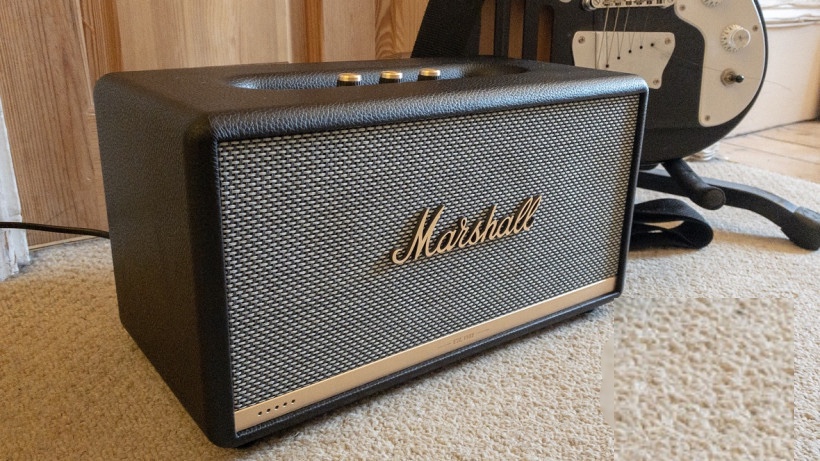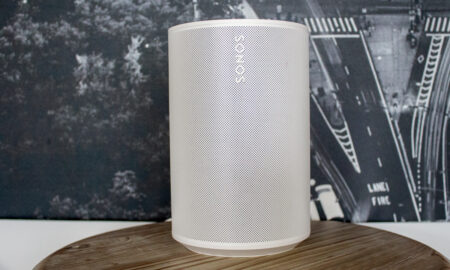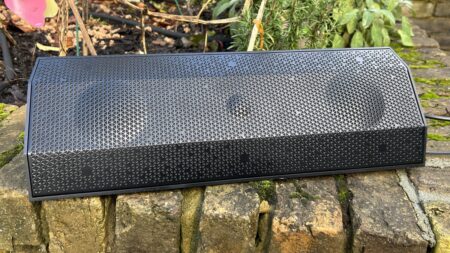Iconic looks and a volume dial that loves to be cranked
Given its connectivity you could quite easily use the Marshall Stanmore II Voice without even invoking Alexa. That doesn’t make it the most naturally usable smart speaker, especially considering its size, but its sound rivals Apple’s HomePod and its smarts are far superior. If musical talent is your priority and you’ve got the cash to spend, you won’t find many better options than the Stanmore II Voice.
Pros
- Big, bold sound
- Great looks
- Excellent build quality
Cons
- No multiroom
- Voice recognition could be better
- Simplistic app
Until now, if you wanted a smart speaker that didn’t make a dog’s dinner of playing your Spotify Discover Weekly playlist, the Sonos One was the obvious purchase. But with more smart speakers becoming audiophile-friendly, it’s no longer such a simple choice.
Marshall’s Alexa-infused Stanmore II Voice is the latest to make a play for your cash, offering iconic looks and a big, brash sound that could probably drown out a dozen Echos without breaking a sweat.
But is it all mouth and no leather trousers? We spent a few weeks with one blaring to find out.

Marshall Stanmore II Voice: Design and setup
The Stanmore II Voice only comes with a flimsy pamphlet of basic instructions, so it’s a good job it’s ridiculously easy to set up. Plug it in, download the Marshall Voice app for your phone and the speaker will show up on screen. Connect it to your Wi-Fi network, log in to your Amazon account and it’ll be good to go.
In fact, you could quite easily use a Stanmore II Voice without ever having to touch it. It’s mains-powered but there’s no power switch or remote. The app lets you control playback, switch between sources, change the volume and fiddle with its EQ settings. The only thing you can’t do is browse your phone’s music library or select a song from your favoured streaming service.
Smaller choice: Marshall Uxbridge Voice review
Pretty much all of those controls are replicated in button or knob form on the speaker’s brass top plate, plus there’s also one you can use to activate or mute Alexa. Next to that is the play/pause button: double-tap it to skip a track, or triple-tap to go back.

In case it wasn’t obvious, the Stanmore II Voice is designed to look like the cab of a Marshall amp, so the volume and EQ rotary dials look like the ones Nigel Tufnel turns up to 11 in Spinal Tap. Sadly, these only go to 10, but they do now come ringed with LEDs that show what level they’re set to.
Despite the Stanmore II Voice’s obvious influences, Marshall has managed to make it not look too novelty, which is probably helped by the fact that the all-round finish and build quality is excellent. Its wooden frame is wrapped in black textured vinyl, while the cloth covering on the front has the famous logo mounted in the middle.
At 4.75kg it’s pretty hefty, and its 35×19.5×18.5cm dimensions mean it’s physically larger than most smart speakers too, so you’ll have to clear a space for it rather than just squeezing it in somewhere convenient.
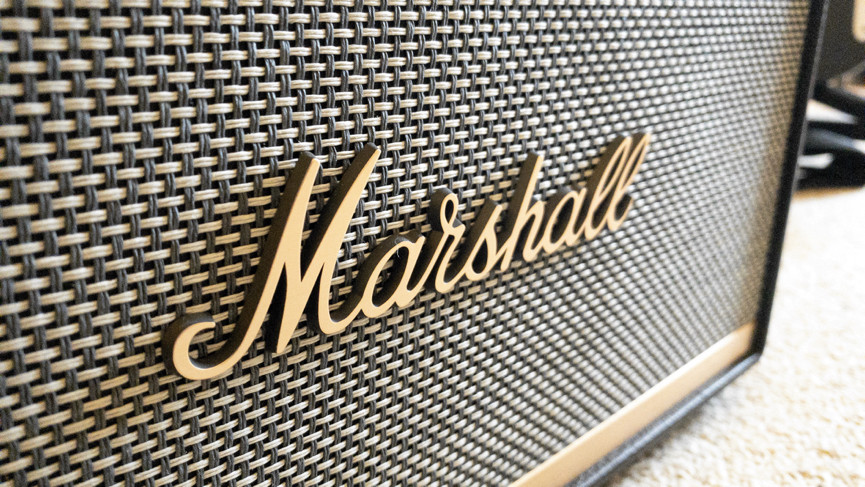
Marshall Stanmore II Voice: Features
The Stanmore II Voice’s feature list isn’t an exhaustive one but it does most things you’d expect from a wireless speaker.
In terms of connectivity, there’s Wi-Fi and Bluetooth but no AirPlay 2. Despite the built-in Wi-Fi there’s no support for DLNA (which allows devices to communicate on a local network), but it does work with Spotify Connect, which, after voice control, is just about the easiest way to play stuff from the streaming service. You just select the Marshall from your list of devices within the Spotify app or web player and away you go.
Of course, Alexa also supports various other streaming services, so you can also play from Deezer or Amazon Music if you have the relevant subscription, but you’ll need to rely entirely on voice to control them.
If you want to play something that’s stored locally on your phone, connecting via Bluetooth is simple enough and only gets easier after you’ve done it for the first time. Just say, “Alexa, connect my phone,” and it’ll hook the two up.
Essential reading: The best multi-room speaker systems
If you want to go wired there’s a 3.5mm input on top, so with the correct cable you can plug in anything with a headphone socket, and next to the bass port round the back there’s an old-fashioned RCA connector. These are handy to have but it feels like anyone buying this kind of smart speaker will mainly use streaming to provide the tunes.
Where the Stanmore II Voice is lacking is in multi-room skills, although Marshall says they’re “coming soon”. The company already makes a multi-room system so support for it here surely can’t be far away.
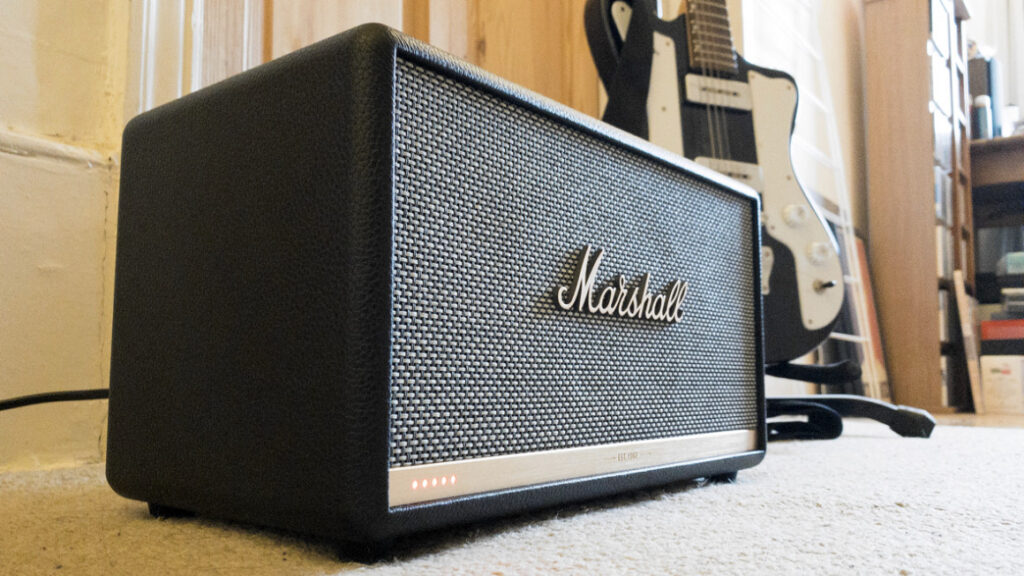
Marshall Stanmore II Voice: Smarts
When you say your chosen wake word a set of five LED lights on the front of the Marshall illuminate to indicate that Alexa’s listening. These turn red when you’ve got Amazon’s assistant on mute.
The Stanmore II Voice will do pretty much everything a regular Echo speaker can. You can set timers, ask questions, order items from Amazon, and control music on other Echo devices, although calling with Alexa isn’t supported (yet). You can also control smart home kit, although unlike the Echo Plus there’s no hub built in, so you’ll have to have separate ones plugged in if you want it to control your lights, heating, etc.
Despite only having two microphones to pick up your voice the Marshall is pretty good at responding to commands. The only time you’re likely to encounter any issues is if it’s gone into standby, in which case it takes a little longer to respond, or if you’ve got it playing music at a fairly unsociable volume. But if you don’t want to turn it down, you can always just press the Alexa button on top.
You sometimes have to be slightly more deliberate with how you speak, and if you pause for too long Alexa will get impatient, which makes use of it slightly less natural than an Echo, but it’s responsive enough to avoid being frustrating.

Marshall Stanmore II Voice: Sound quality
There is a regular Marshall Stanmore II Bluetooth that comes without Alexa, so what we have here really is a speaker that just happens to have had an AI assistant added to it – and that’s pretty obvious when you play some music through it.
Inside there’s a trio of amplifiers: a 50-watt one to power the 13cm woofer and a 15-watt pair for the two 19mm tweeters. Combined with its physical size that means the Stanmore II Voice is capable of producing a nice, full sound that’ll fill a room easily, even at only half volume.
If you do need to crank it up the Marshall has plenty of oomph. Anything over about seven on the volume dial could quite easily result in a knock on the door from the neighbours, although if you’re lucky they might just want to compliment its ability to go so loud without distorting.
It’s not a tactless loudmouth either. Songs sound detailed and clear, while the bass is powerful but well controlled, with plenty of texture to boot. Unsurprisingly it’s particularly adept at reproducing guitar tones but overall there’s real balance to the Stanmore II Voice’s sound. It’s fun to listen to as well, especially if you nudge that volume dial a bit higher than usual.
Twiddle the EQ dials on top and you can adjust the bass and treble to your liking, but if you fire up the app you’ll get sliders that offer even more control over how the speaker sounds, plus a choice of seven different presets: flat, rock, metal, pop, hip-hop, electronic and jazz.
You could probably leave it on the default flat one for everything and not feel short-changed by the Stanmore II Voice’s performance, but switching between them depending on the genre of music you’re listening to does make a difference – it’s just not a deal breaker.


